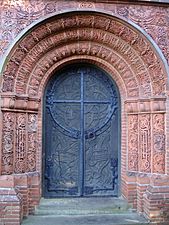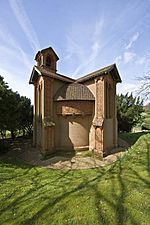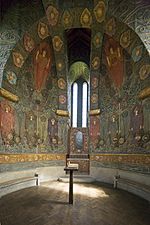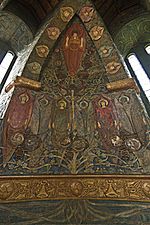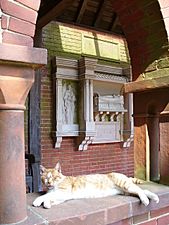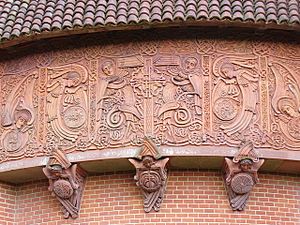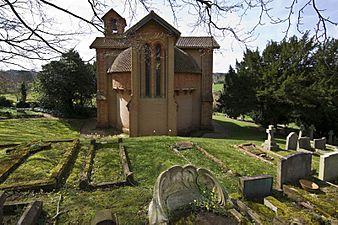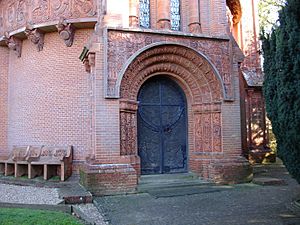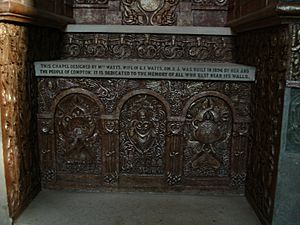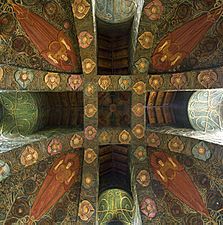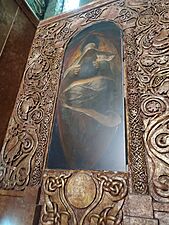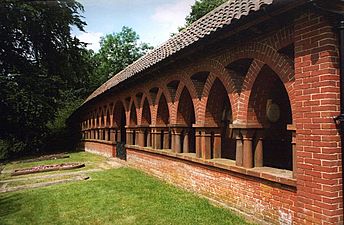Watts Cemetery Chapel facts for kids
Quick facts for kids Watts Cemetery Chapel |
|
|---|---|
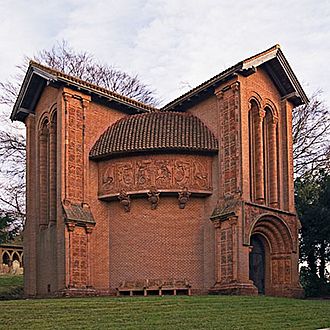 |
|
| General information | |
| Architectural style | Gothic Revival |
| Town or city | Compton, Surrey |
| Country | England |
| Coordinates | 51°13′04″N 0°37′56″W / 51.21775°N 0.6321°W |
| Construction started | 1896 |
| Completed | 1898 |
| Client | Watts Gallery |
| Design and construction | |
| Architect | Mary Fraser-Tytler |
|
Listed Building – Grade I
|
|
| Official name | Watts Memorial Chapel |
| Designated | 14 June 1967 |
| Reference no. | 1029541 |
The Watts Cemetery Chapel or Watts Mortuary Chapel is a very special building in the village cemetery of Compton in Surrey, England. It was designed by Mary Fraser-Tytler, an artist who lived in the village. She was married to the famous painter and sculptor George Frederic Watts.
The chapel's design mixes different styles, including Art Nouveau and Celtic Revival art. It has many detailed carvings and paintings made from terracotta, which is a type of baked clay. Local experts describe it as a unique blend of Art Nouveau, Celtic, Romanesque, and Egyptian influences, all mixed with Mary's own creative style. The chapel is a Grade I listed building, which means it's a very important historic site.
History of the Chapel
When the Compton Parish Council decided to create a new cemetery, Mary Fraser-Tytler offered to design and build a new chapel for it. Mary and her husband, George Frederic Watts, had recently built their home, "Limnerslease," nearby. This house is now part of the Watts Gallery.
Mary Fraser-Tytler was a supporter of the Home Arts and Industries Association. This group was started in 1885 to encourage people, especially those with less money, to learn and practice handicrafts. The chapel project was Mary and George's way of helping their community through art and creativity.
Building the Chapel
A group of local people, including many who later helped Mary start the Compton Potters' Arts Guild, built the chapel between 1896 and 1898. Almost everyone in the village helped out! The chapel has a round shape, and from the outside, it looks a bit like an old Roman chapel.
Villagers were invited to help decorate the inside of the chapel under Mary's guidance. This is why the interior combines Art Nouveau and Celtic styles with Mary's unique artistic touch. Each person in Mary Fraser-Tytler's evening art class, led by Louis Deuchars, had a specific job. In total, 74 villagers from Compton took part in decorating the chapel. George Frederic Watts paid for the entire project. He also painted a special version of his artwork, The All-Pervading, for the chapel's altar just a few months before he passed away.
Messages and Memorials
The graves around the chapel have special sayings inspired by the Arts and Crafts movement. One example is "The Morning Stars Sang Together." Inside the chapel, you can read, "Their hope is full of immortality but the souls of the righteous are in the hands of God."
Both Mary and George Watts have memorials in a covered walkway, called a "cloister," near the chapel. Many of the memorials in the cemetery are made from unglazed terracotta, even after the local Compton Pottery closed in the 1950s. Famous members of the Huxley family, including Julia Huxley and her sons Aldous Huxley and Julian Huxley, are also buried in this cemetery.
The Watts Cemetery Chapel is open to visitors. You can visit Monday to Friday from 8 AM to 5 PM, and on Saturdays, Sundays, and bank holidays from 10 AM to 5:30 PM. There is no charge to enter. The chapel is managed by the nearby Watts Gallery, which celebrates the work of Mary Fraser-Tytler and her husband.
Gallery
-
Chapel view showing campanile
-
Chapel, showing in foreground terracotta grave marker made in the Compton pottery
-
The Cloister near the chapel


